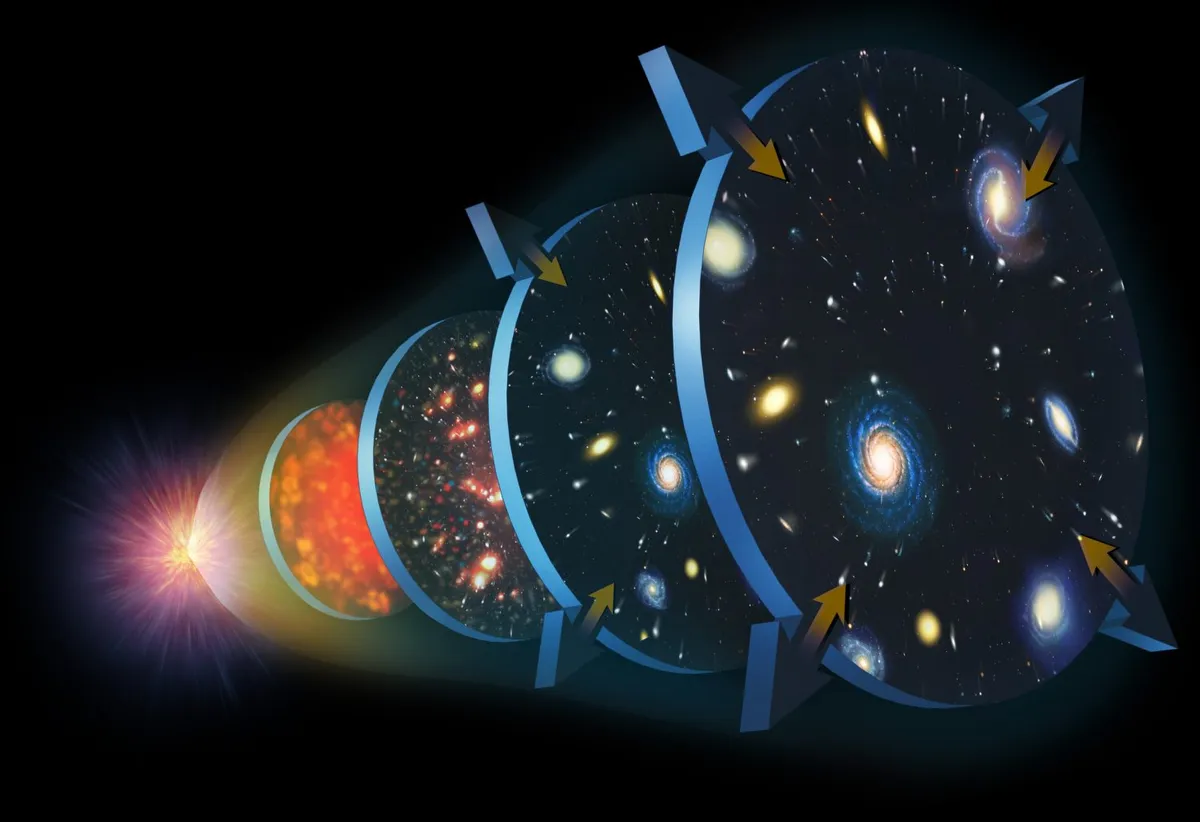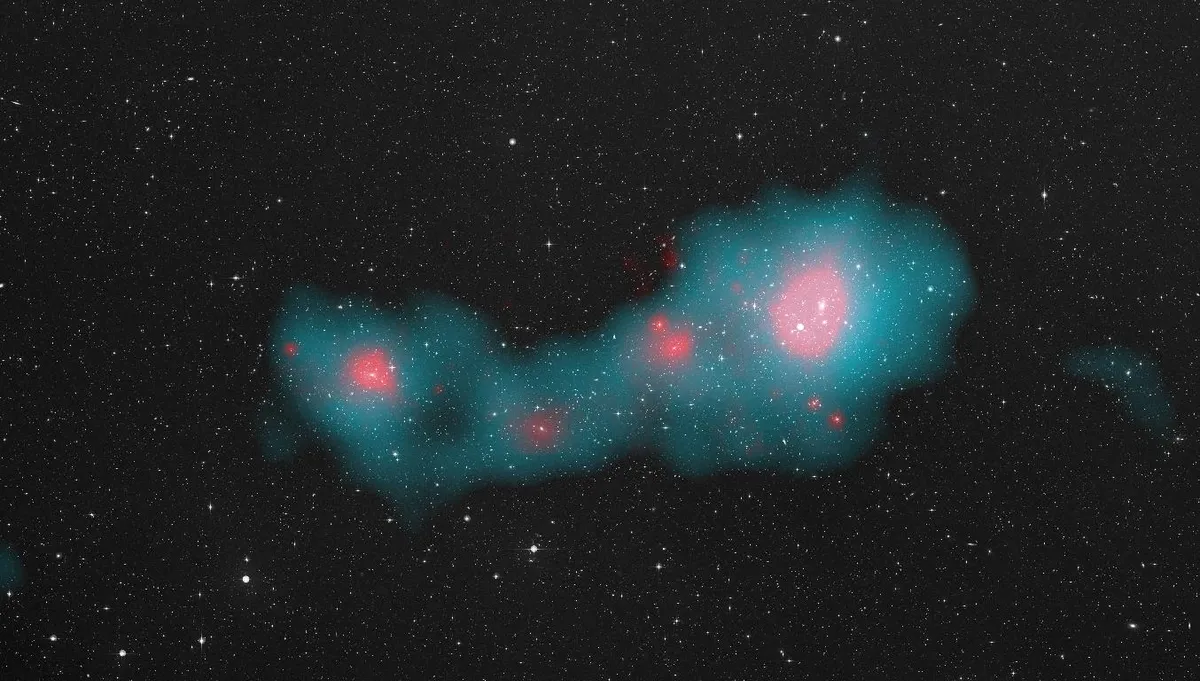The tumultuous history of the Universe can be broken down into eras.
It is a story that starts with a fiery childhood, followed by the growing pains of adolescence and the wild abandon of a mid-life crisis.
More amazing cosmic science

Let’s explore these chapters in its life as we take a trip through the history of the eras of the Universe, looking at what was happening during key moments after the Big Bang.

The first fraction of a second
According to the latest theories, our Universe underwent a colossal growth spurt in its first sliver of a second.
This effect – known as inflation – saw the Universe’s size skyrocket from considerably smaller than an atom to the size of a grapefruit.
That may not sound like much, but it is.
The Universe’s volume suddenly got a million trillion trillion trillion trillion trillion trillion times bigger in a trillionth of a trillionth of a trillionth of a second.
Take an ordinary shipping container and increase its size by the same amount and it would be bigger than the entire observable Universe.
“Due to this rapid expansion, very small quantum fluctuations suddenly stretched,” says Professor Kazuya Koyama, from the University of Portsmouth, UK.
Frozen into the Universe for good, these magnified fluctuations would become slightly denser and sparser regions.
They were the seeds that would much later become the vast superclusters and supervoids we see in the Universe today.
Initially, the fundamental forces – the strong, weak and electromagnetic forces, and probably gravity
– were all one.
Yet, very quickly they peeled away from each other during this early era.

The first second
Before this point, the Universe was a sea of energy and subatomic particles.
But as the Universe started to grow and cool a little, the particles slowed down and the newly separated fundamental forces were able to stick some of them together.
Particles called quarks found themselves bound into groups of three to form protons and neutrons.
A solitary proton is the heart of a hydrogen atom, the simplest atom in the Universe, meaning the nucleus of the first element on the famous periodic table had appeared.
Hydrogen is a form of matter, but when energy turns into particles it creates equal quantities of matter and antimatter.
For every quark, there should also have been an anti-quark.
When matter and antimatter meet, they destroy each other and turn back into energy.
If matter and antimatter really were created equally within the first second, then both should have disappeared completely by the time we reach the present day.
Instead, astronomers suspect that the infant Universe had a slight bias for matter.
For every billion antimatter particles made in the first second after the Big Bang, a billion and one matter particles appeared.
All the antimatter then disappeared along with almost all the matter. Stars, planets – and even ourselves – are made from this tiny residue of matter.

The first 20 minutes
Once hydrogen had appeared, a new construction mechanism was possible: fusion, the same process that powers the Sun.
Every second, the Sun turns 620 million tonnes of hydrogen into 616 million tonnes of helium. The ‘missing’ tonnes are converted into sunshine.
The process starts when two protons – the nuclei of hydrogen atoms – fuse, or stick together. Yet both particles are positively charged.
As with matching magnetic poles, their natural instinct is to repel one another.
This desire can only be overturned by extremes of temperature and pressure that force them together anyway.
Today, those conditions are only found inside stars. Yet in the first 20 minutes after the Big Bang, the Universe itself was hot enough for fusion.
After 20 minutes, though, the Universe had further expanded, dropping the temperature and switching hydrogen fusion off.
This left behind a Universe made of 75% hydrogen and 25% helium (by mass).
Things did rumble on a little further, though.
"One in a million [atomic nuclei] were still being created even a day after the Big Bang," says Ryan Cooke at Durham University.
These include heavier versions of hydrogen, such as deuterium and tritium, plus helium-3 and beryllium-7.

The first 380,000 years
Next, the Universe underwent a period that can only be likened to the tumbleweed in old Western movies. Nothing much happened.
The Universe was too cool to make new particles or to fuse existing particles.
Things changed some 380,000 years after the Big Bang. Previously, the Universe was so hot that subatomic particles called electrons were flying around at breakneck speed.
Now, though, the Universe had cooled enough that nuclei could grab passing electrons and bind to them.
The first complete atoms formed in an event known as ‘recombination’.
With electrons now tucked away, suddenly there was a lot more empty space between atoms.
The light that had been left over from the Big Bang, which had previously been trapped by the log jam, was now free to stream outwards and the Universe became transparent.
Today we see this sudden release of energy as the Cosmic Microwave Background (CMB).
If the Universe were an 80-year-old person, the CMB is a snapshot of it at just 19 hours old.
"The CMB has small temperature variations, about one part in 100,000," says Koyama.
These correspond to the tiny quantum fluctuations that were magnified by inflation right at the start of the Universe.

One billion years
Astronomers are still unsure as to when exactly the first stars appeared, but it is usually pegged at within the first few hundred million years after the Big Bang.
Efforts have been made to find the first stars in early galaxies, but they can’t be seen directly because there was too much gas and dust in the way of their light.
They also lived fast and died young, within just a few million years.
Instead, astronomers look for the way they polluted the gas clouds around them with the by-products of fusion: elements heavier than hydrogen and helium, formed via the fusion in the heart of these stars.
"It’s like a crime scene," says Cooke. "We’re looking for the unique fingerprint of the first stars."
Upcoming telescopes could be a real game-changer in this regard.
The Extremely Large Telescope, for example, currently set for completion in 2028, will have 100 times the light-gathering power of the Hubble Space Telescope.
Solving this particular celestial whodunnit is important work.
"It was one of the most transformative times in the Universe’s history," says Cooke.
"It went from being dark, to all of a sudden the first star igniting and creating most of the elements in the periodic table other than hydrogen and helium."
In other words, the first stars kick-started huge chemical changes in the Universe that made stars like the Sun – and planets like Earth – possible.
It’s also around this time that the very beginning of the modern-day structure of the Universe, with its sprawling superclusters and supervoids, tentatively began to take shape, building on the seeds sown during the Universe’s early inflationary era.

Nine billion years
Aeons on from the Big Bang and you might expect, as most astronomers did, that the Universe’s expansion would be slowing.
But there came an almighty shock. In 1998, two separate research teams reached the same staggering conclusion: not only is the Universe’s expansion not slowing down, it’s actually gathering pace.
What could be driving this acceleration?
Astronomers don’t yet know, so they call it ‘dark energy’. What could it be?
"The first option is what’s called the cosmological constant," says Koyama.
The idea is that even empty space has an intrinsic property that works to counteract gravity.
As the name suggests, the strength of this energy remains constant.
But as the Universe expands and galaxies move further apart, the collective strength of their gravitational attraction diminishes.
There came a point, around five billion years ago, when suddenly the strength of this attraction dipped below the might of the cosmological constant.
Unshackled, the Universe’s expansion began to accelerate away.
Tantalisingly, however, Koyama says recent findings suggest that dark energy isn’t constant after all. Instead, whatever it is has become stronger over time.
"It’s just a hint," Koyama says. "We need more evidence to be sure."
That data could soon be on the way, thanks to the Dark Energy Spectroscopic Instrument (DESI), the Euclid telescope and the upcoming Nancy Grace Roman Space Telescope.
Their observations could be key to predicting what the next era of our Universe will be.
This article appeared in the April 2025 issue of BBC Sky at Night Magazine
